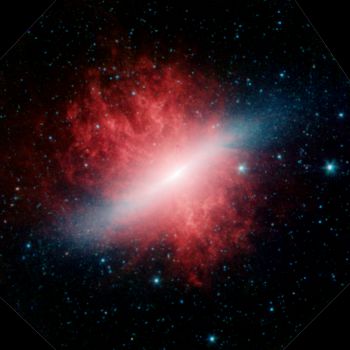3 May 2013
Physicists analysing observations from the Herschel Space Observatory have shown that galaxies in the early Universe were cooler than those we see around us today.
The study draws on the star survey work of the HerMES project1 led by Professor Seb Oliver at the University of Sussex and indicates that early galaxies were more bloated, contained more dust and were distributed over larger regions than previously thought.
Around a thousand galaxies were studied, chosen because they are very distant and forming stars at very high rates. Because they are so distant, the galaxies are seen as they were when the Universe was much younger, with those studied here spanning a range of cosmic times between one and ten 10 billion years ago – a significant portion of the Universe’s fourteen billion-year history.
Most of these galaxies are seen when the Universe was about half its current age, a period during which galaxies tended to be much more “active” than those we see around us today, with some forming stars hundreds or even thousands of times faster than our Milky Way.
Although rare, such “starburst galaxies” have produced as much energy over the course of cosmic history as all the other galaxies combined. This makes them crucial for studying the history of star formation in the Universe.
Dr Myrto Symeonidis, who led and carried out the research at UCL and is currently based at the University of Sussex, says: “These galaxies are all but invisible to optical telescopes, but Herschel sees the far-infrared glow from their dust. With so many galaxies in the Herschel images, we can start to look at how galaxies have changed over the history of the Universe.”
Stars form from massive clouds of gas and dust, and these early galaxies have large quantities of both. Most of the dust in these galaxies is cold by human standards, at temperatures of around −240 Celsius, and so can only be seen at far-infrared wavelengths. Using Herschel’s cameras, astronomers are able to study the properties of the dust and deduce the average conditions within each galaxy.
The newly formed stars in these galaxies heat up the dust, so galaxies which form stars more rapidly are expected to have higher dust temperatures overall. But the surprise for astronomers was that the galaxies in the younger Universe appeared cooler than those seen today.
Dr Symeonidis says: “There are two explanations for this surprising result. Either the earlier starburst galaxies were much larger than we thought, or they contain greater quantities of dust than predicted. In either case, they are different from those we see around us today.”
The results used images and data from Herschel’s two cameras, PACS and SPIRE. By studying seemingly blank regions of sky for long periods of time, these revolutionary instruments picked out the light from thousands of galaxies in the early Universe.
HerMES leader Professor Oliver says: “Previously it was generally assumed that these early starburst galaxies were similar to those in the local Universe. “What we’ve shown here is that this wasn’t always the case. We need to look more carefully at the conditions in these early galaxies.”
The study is the last to be concluded during Herschel’s four-year mission to increase our understanding of the evolution of the Universe by observing cold and dusty objects in deep space.
Since Herschel was specifically designed to look at cold and dusty objects, the entire spacecraft had to be cooled to very low temperatures of almost absolute zero (-273 Celsius). This was achieved by seating the telescope on top of a giant tank of liquid coolant – helium. Herschel has now run out of coolant, bringing Herschel’s mission to an end.
The work of the scientists, however, continues, as they have a massive amount of unexplored data from Herschel.
Professor Oliver says: “This is a significant moment for everyone who has worked with the Herschel space observatory. It has been fantastically successful mission and has already achieved a huge amount. We will continue to learn more about the Universes as we work on the mass of data still to be analysed in the coming years.”
The results are published in the 1st May 2013 edition of the journal Monthly Notices of the Royal Astronomical Society: Symeonidis et al (2013) MNRAS 431, 2317
1 HerMES is the Herschel Multi-tiered Extragalactic Survey, an astronomical project to study the evolution of galaxies in the distant Universe. It is the largest project on ESA's Herschel Space Observatory. The project is carried out by a large team, made up primarily of people who built one of the instruments on Herschel called SPIRE.















